Aquatic Weeds: Biology, Diversity and Grower Assestment of Presence on Cranberry Farms (2021)
Aquatic weeds grow in reservoirs, ditches, estuaries, and other bodies of water. They are generally classified by the way they grow: submerged (growing entirely below the water’s surface), emergent (growing out of the water), or free-floating (float flat on the water’s surface). Although aquatic weeds can serve as habitats for aquatic insects, they can disrupt native plant communities (Langeland 1996) as well as agricultural systems that rely on consistent and easy access to water resources, such as cranberry.

Cattails and waterlilies.
Aquatic weed prevalence on MA cranberry farms. A survey to assess the occurrence and impact of aquatic plants on commercial cranberry bogs was sent to 333 Massachusetts cranberry growers in August 2020. Twenty-six were returned by mail and 33 responses were collected via Google Form for an 18% response rate.
The data indicated that the most prevalent aquatic weeds on, in, or around waterways or water bodies associated with commercial cranberry bogs are water lily, sedges, watermilfoil, rushes, arrowhead, and hydrilla. When growers were asked whether they considered these aquatics to be problematic, 53% said duckweed was a problem on their farms. For the remaining species, the percentage indicating the plant was a problem: rushes (41%), arrowhead, hydrilla, and sedges (36%), watermilfoil (34%), water lilies (24%), cattails (20%), pickerelweed (12%), and bladderwort (8%).

Estimations of prevalence of infestation of emergent and submerged aquatic weeds by MA cranberry growers in 2020.
Aquatic Weed Identification – Emergent Plants
Arrowhead
Sagitaria latifolia is a native, emergent plant characterized by its arrow-shaped leaves that have 3 distinct points. The leaves grow in clusters from the base. The stems of the leaves (petioles) are spongy, and each leaf has a central vein. Flowers form at the end of the stem stalk; they can be white to light pink in color. Arrowhead plants thrive in waters with high phosphate and high hardness (calcium carbonate) levels, and the plant can grow up to 4 feet tall.
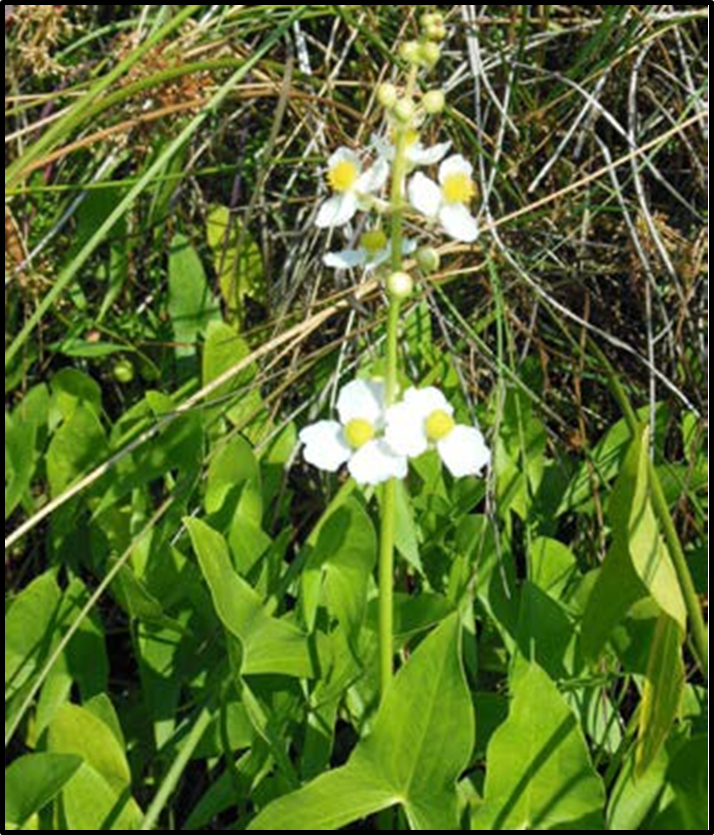
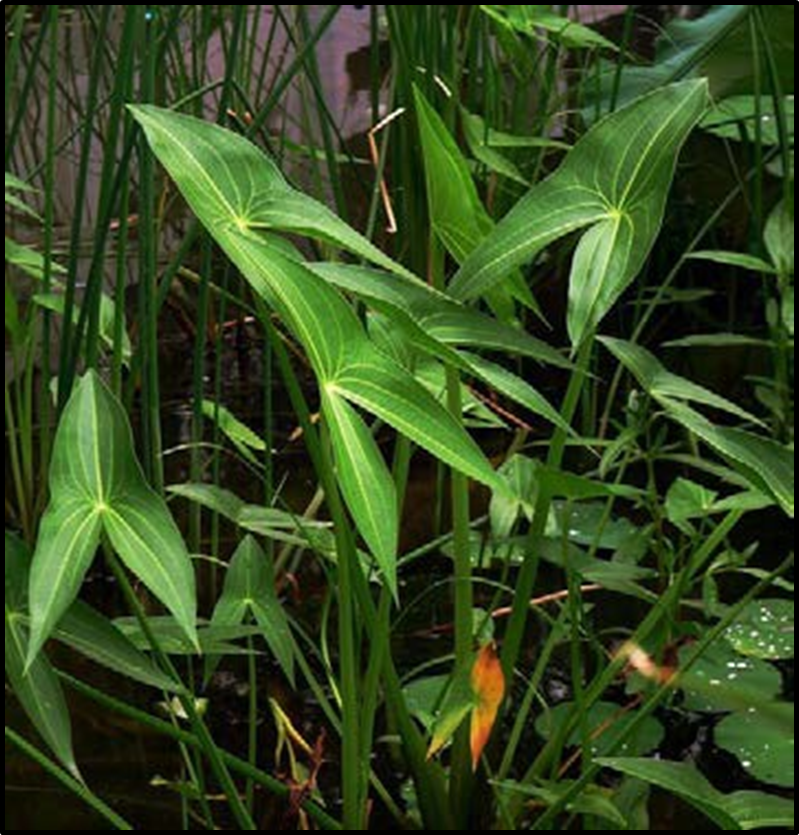
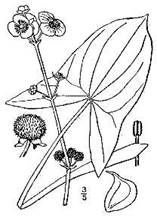
(Left) Arrowhead, (Center) Close-up of an arrowhead, (Right) A diagram of an arrowhead from USDA-NRCS PLANTS database. Created by Britton, N.L., and A. Brown (1913).
Pickerelweed
Pontederia cordata is a native, emergent plant characterized by its heart–shaped leaves and blue or purple flowers. The flowers grow in clusters that grow 3 to 4 inches in length at the top of the stem, and each flower lasts for only 1 day. The leaves are large and have veins that run parallel to them. The main stem is light green and grows underwater. The plant can grow to 3.5 ft tall and each leaf can be up to 7 inches long.



(Left) Pickerelweed, (Center) A close-up pickerelweed flower by Robert H. Mohlenbrock, from USDA- NRCS PLANTS database, (Right) A diagram of a picklerweed from USDA-NRCS National Wetlands Team.
Duckweed
Lemna minor is an emergent plant that grows in dense colonies in undisturbed water. This aquatic plant is characterized by flat leaves that grow 3 to 4 on a stem. Each plant has a single root and many plants will cluster together to form colonies, usually with 2 to 5 plants together. This aquatic plant can cause oxygen depletion and eliminate other submerged plants if left
unmanaged for extended periods of time.
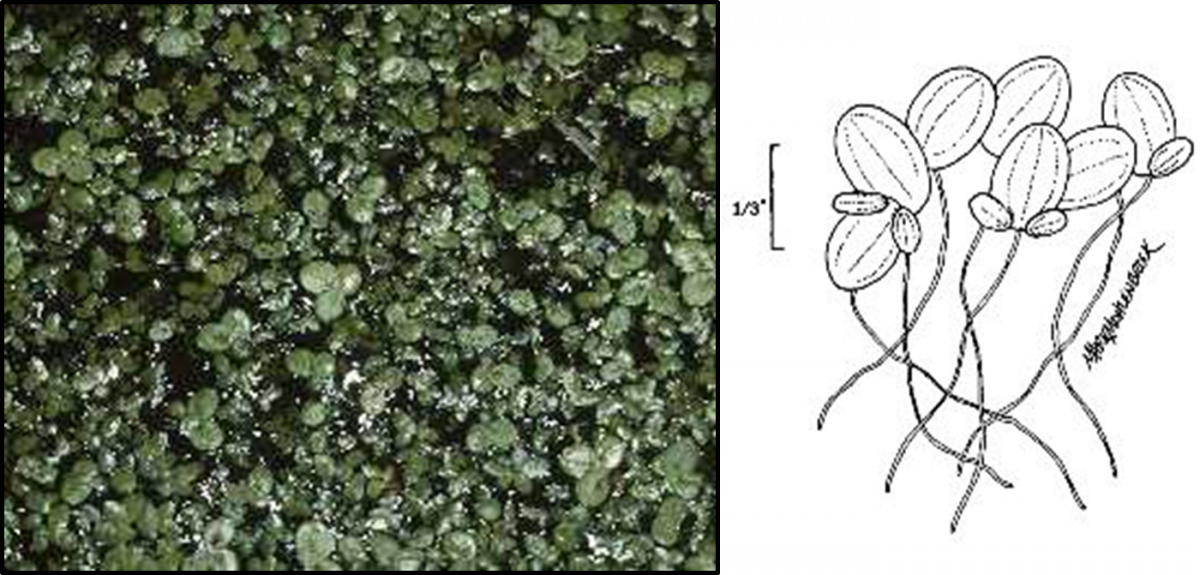
(Left) Duckweed close-up by Robert H. Mohlenbrock, from USDA-NRSC PLANTS database, (Right) A diagram of duckweed from USDA-NRCS PLANTS database.
Rushes and Sedges
Rushes (e.g., Juncus spp.) and sedges (e.g., Carex spp., Carex aquatilis) are emergent plants characterized by grass-like leaves that grow as a single stem or as a group of stems. Each stem is connected by thick, long rhizomes. A key identifying characteristic used to distinguish sedges and rushes is the shape of the stem; sedges typically have a triangular stem while rushes are characterized by a round stem filled with a white pith. The presence of rushes and sedges can be beneficial as they can hold slopes in place and minimize erosion.

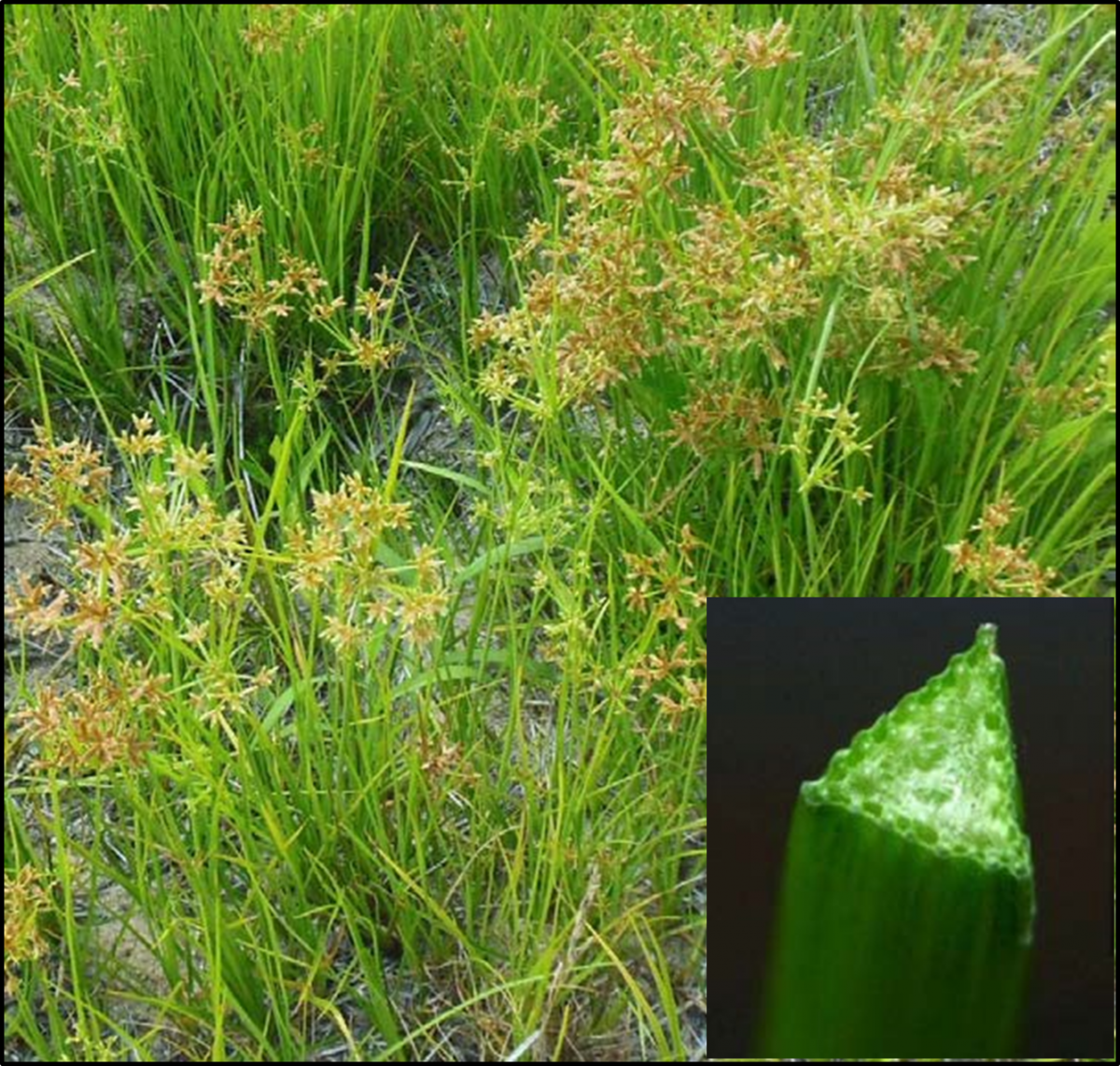
(Left) Rushes have round stems filled with white pith, (Right) Sedges typically have triangular stems.
Aquatic Weed Identification – Submerged Plants
Watermilfoil
Myriophyllum spp. is a native, submerged plant. The leaves of watermilfoil are feather-like, with four leaves radiating from a single point (forming a whorl). Hand-pulling, raking, or cutting can help control this plant, but all fragments must be cleaned up because they will regenerate into new plants. Watermilfoil is not to be mistaken with the invasive Eurasian milfoil, which can be recognized by its abundant branching leaves versus the native watermilfoil’s sparse stem of leaves.
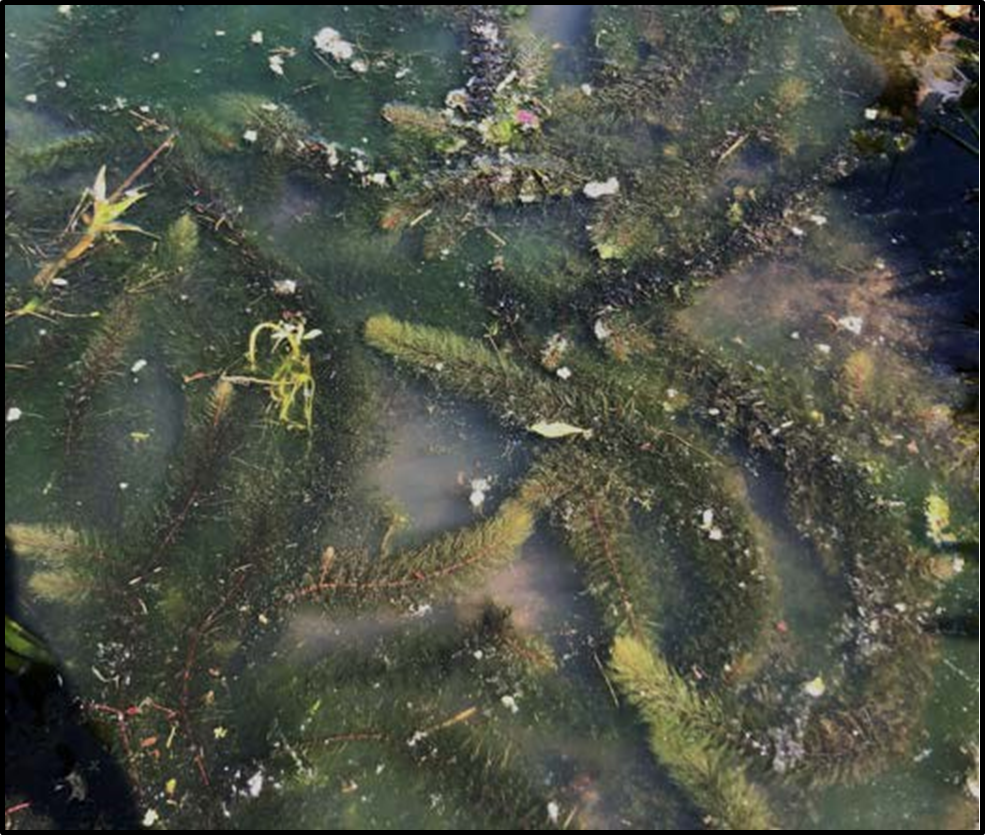
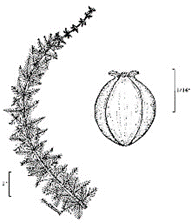
(Left) Watermilfoil, (Right) A diagram of a watermilfoil from USDA-NRCS PLANTS database. Created by Britton, N.L., and A. Brown (1913).
Bladderwort
Utricularia spp. is a submerged, aquatic carnivorous plant characterized by yellow flowers that grow above the water. This plant has “bladders” on the stem that catch small aquatic organisms and insects. This is a perennial plant that can be found in nonturbulent, shallow, acidic waters.
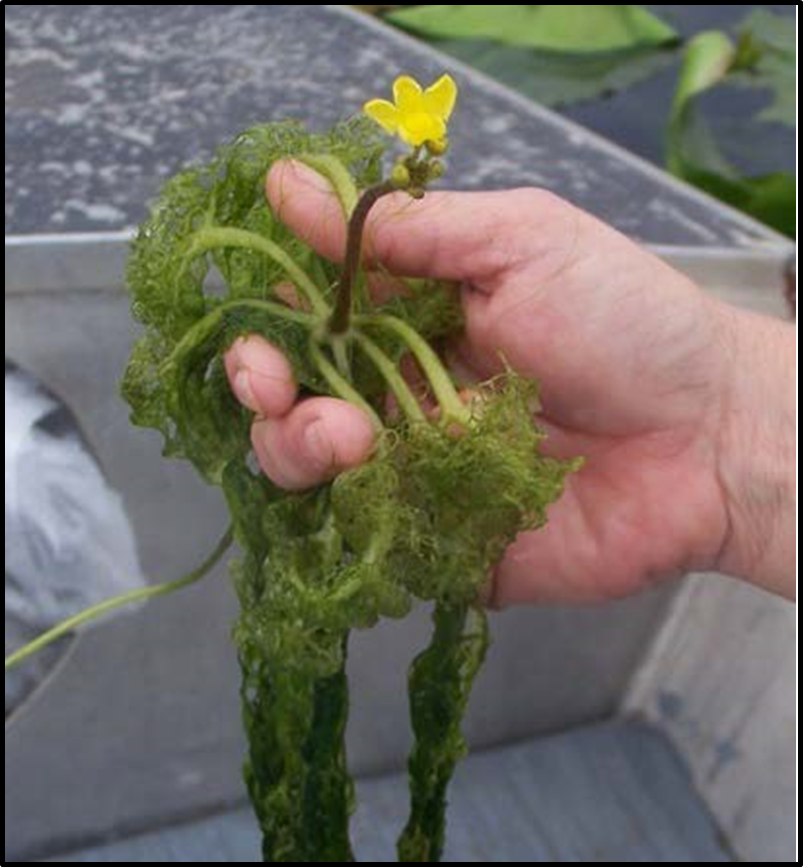
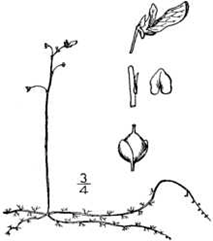
(Left) Bladderwort photo by Lyn Gettys, (Right) Bladderwort line drawing from USDA-NRCS PLANT database.
Hydrilla
H. verticillata is a submerged, invasive plant species. It is characterized by small leaves with serrated edges and pointed leaves that are bright green in color. They have 3-8 whorls per stem, which are leaves coming from one point. This plant has thin stems that can grow up to 1 inch per day. The plant is rooted into the bed of the waterbody. The stem grows upwards and branches at the water’s surface, where the plant then grows horizontally on top or just below the water’s surface. These plants are very difficult to eliminate because new plants can grow from minuscule stem fragments.


(Left) Hydrilla photo by Lyn Gettys, (Right) Hydrilla close up photo by Jon Sullivan.
Non-chemical management options for aquatic weeds include raking, digging, and physical pulling of the weeds by the root system. Care should be taken to not leave parts of weeds or weed fragments behind after raking or pulling because they can re-grow into new plants. Collaboration with local town governments to clean up aquatic weeds in shared water resources may also be necessary.
Further Information
For more information on aquatic weed identification, visit the linked sites below, contact your town’s Conservation Commission, or contact the Cranberry Station.
MA Dept of Conservation Resources: Guide to Aquatic Plants
Northeast Aquatic Plant Management Society